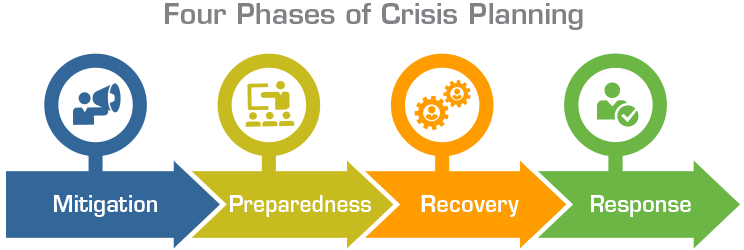Emergency Management Training
Enroll in our eight-hour class to master the four phases of crisis planning to ensure your staff are prepared to help prevent and respond to emergencies.
This 8-hour class takes attendees through the four phases of Crisis Planning enabling staff at all levels to help prevent and respond effectively to emergencies.
The class enables attendees to proactively address the many phases of emergency management, as outlined in the All Hazards Approach to school safety.
Proactively planning and drilling with the local emergency first responders is discussed in depth as well as the development and implementation of table-top exercises.

INCIDENT COMMAND SYSTEM-100-FOR SCHOOLS
Successful partnerships with local authorities are required for an effective response to an incident. The Incident Command System is your standardized all hazard incident management plan to be used on-scene should an incident occur. Your plan provides seamless and appropriate interfacing with first responders given the nature of the incident.
This 4-hour class is a must for K-12 personnel who are included in the preparation of the District and school building level emergency response plans. The plans specifically address duties and responsibilities, from Incident Commander to command staff. Plan preparation can be done online and followed with a team meeting.
NATIONAL INCIDENT MANAGEMENT SYSTEM (NIMS) – INTRODUCTION
The goal of NIMS is to keep improving the nation’s response to emergencies and the Federal government has mandated that all municipalities in each state be NIMS compliant to continue to receive Federal grants. This 4-hour course satisfies the Federal mandate.
NEW YORK STATE EMERGENCY RESPONSE PLANS
Join us for a review and training on best practices for preparing NYS Emergency Response Plans. We recommend that Central Office administration and ALL building principals attend the same 2-hour training session. This ensures a coordinated approach to comprehensive plan preparation and development and maximum information sharing.
THREAT ASSESSMENT IN THE EDUCATIONAL ENVIRONMENT
Understanding the threat assessment process and how to apply it to your school or district is one of the best ways to be ready when an incident occurs.
During the 4-hour class, you and your staff will learn about the threat assessment model that was developed and is espoused by the U.S. Secret Service. This model has been instrumental in averting incidents and in providing the necessary intervention to children in need.
Attendees get an in-depth look at:
- The threat assessment process in the K-12 environment
- The theory behind the case for developing a threat assessment team
- The need for intelligence sharing and gathering among groups and agencies which typically do not interact or share information
- Accomplishing the threat assessment without violating laws relative to the individual’s right to privacy. What about FERPA?
- The threat assessment model was developed and is espoused by the U.S. Secret Service and has been instrumental in averting incidents and in providing the necessary intervention to children in need.
BOMB THREAT AWARENESS AND MITIGATION FOR EDUCATION
Every bomb threat warrants an investigation and classification. That is why this 4-hour class should not be missed by your school. Attendees will learn how to plan, investigate, address, classify, and recover from a bomb threat.
This class will also cover sections on NYS Penal law, law enforcement notifications and the anticipated response of local law enforcement and their building searches and investigations.
SITUATIONAL AWARENESS
This interactive, tabletop and functional exercise class is appropriate for all aspects and job descriptions in K-12 education. Together, we will analyze and mock-implement best practices espoused by many government agencies as to how to best prepare and respond to certain crisis situations. K-12 and law enforcement responses to an active shooter scenario are discussed. We also tabletop how the phrase, situational awareness, relates to best practices. Thinking outside the box is covered in-depth.
NONVIOLENT CRISIS INTERVENTION
Our Crisis Prevention Institute (CPI) instructors will train K-12 staff that could be in a position of having to respond to and mitigate an incident. Staff will be certified in the proper techniques for safely addressing and deescalating potential incidents which could rise to the level of necessitating intervention.
Class is conducted on-line and in-person and requires a minimum of 8 hours for certification.
ASSEMBLING A CRISIS RESPONSE TEAM
Enroll in this class for a look at the factors which should be considered when deciding which personnel are likely to adapt and contribute to your Crisis Response Team.
Traditionally, districts develop a team based upon “titles”, which are historical in nature to a particular building. In this session, we have instructors in the fields of education, emergency management and law enforcement that discuss the philosophy that Crisis Response Teams maybe missing some team assets under the traditional model.
DEESCALATION TECHNIQUES AND INTERPERSONAL COMMUNICATION SKILLS
In 2020 and beyond, it is critical for teaching staff, security personnel and chaperones to recognize, prevent and de-escalate the potential of an incident.
Our class is taught based on our philosophy is that the best incident, is no incident. We discuss topics such as response to suspension, athletic events and the understanding of potential consequences associated with particular behaviors. We include Dr. Nicole Gibson’s outstanding perspective on de-escalation. We also recommend this topic as part of security guard training.
